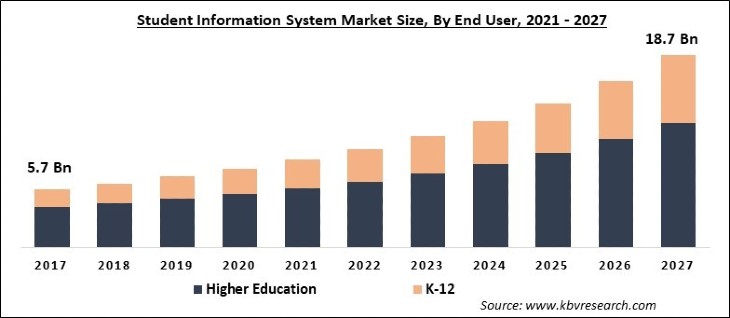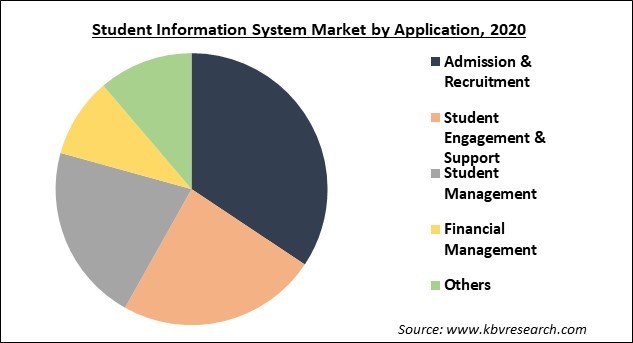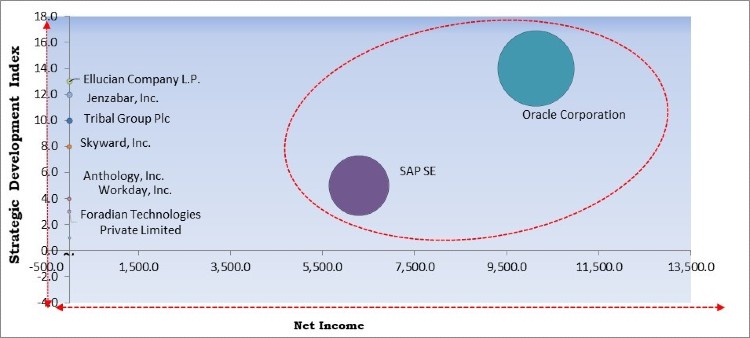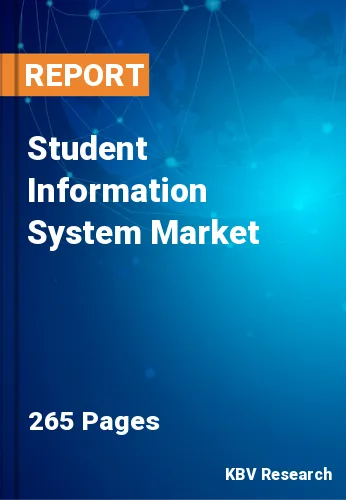The Global Student Information System Market size is expected to reach $18.7 billion by 2027, rising at a market growth of 14% CAGR during the forecast period. A student information system (SIS) is a type of information management system which is used by educational institutions to collect, organize, and analyze student information, allowing the institution to manage its administrative relationship with students as a whole. It supports a broad range of back-office administrator and student-faculty-facing functionality to manage key institutional information assets throughout the student life cycle, including student prospects, applicants, and matriculate courses offered by student course registrations, and grades & transcripts.
Educational institutions and governments around the world are putting a lot of money into education. Several educational institutions have already implemented ERP, eLearning, Learning Management Systems (LMS), and smart education, and among other cutting-edge solutions, to improve internal processes while ensuring quality education. Moreover, they have implemented various programs to improve the standard of eLearning. Educational institutions are also implementing SIS to effectively collaborate and communicate with students, parents, and faculty members, among other stakeholders, in order to keep track of all students, enable educators to create educational content tailored to students' learning needs and improve the overall learning experience.

The latest COVID-19 epidemic wreaked havoc on education professionals around the world. Schools and universities have come to a total standstill as a result of the continuous lockdown and have begun adopting online alternatives to continue the year's scheduled curriculum and tests. Student information systems are projected to increase in nations with adequate network infrastructure and internet penetration in this situation. However, in comparison to the existing need for education, these systems cater to a comparatively smaller number of institutes, and hence cost may become one of the key obstacles in the market expansion, perhaps resulting in a loss of opportunity in emerging countries.
Because of the increasing demand for online education, the outbreak of the COVID-19 pandemic is projected to have a favorable influence on the industry. According to UNESCO data, 1.3 billion students worldwide were unable to attend their educational institutions in March 2020 and required online education to complete their coursework for the academic year 2020-2021. During the COVID-19 outbreak, eLearning technology gained massive popularity, and it is projected to continue to grow after the pandemic to address a similar situation in the future.
This system aids in creating the modern, intuitive experience that students, faculty, and staff expect when transacting business on campus. In addition, these systems also increase operational efficiency by eliminating data silos and paper-based processes and automating workflows, and sustaining financial resources by identifying new revenue sources and eliminating unprofitable programs.
A student information system also facilitates the discipline among the students in an educational institution. It permits students and administrators to communicate easily for follow-up and future reference. The system keeps track of extracurricular activities, including prizes and achievements of each student. A student information system allows the education institute to keep track of students' attendance and add details to their records.
In comparison to the large number of educational institutions, these systems cater to a comparatively smaller number of institutes, and hence cost may become one of the key obstacles impeding the market expansion, perhaps resulting in a loss of opportunity in emerging countries. Implementation cost in integrating the information system requires a significant investment in terms of software, hardware, and personnel.

Based on Component, the market is segmented into Software and Services. The service segment is expected to experience significant growth rate during the forecast period. Training, installation, maintenance, consulting, and support services are all part of the service segment. Integration of apps within academic organizations has proved difficult, time-consuming, and costly. The desire for integration capabilities by institutions to streamline all administrative procedures is driving the expansion of the service segment.
Based on Deployment Type, the market is segmented into Cloud and On-premise. In 2020, the cloud sector had the maximum revenue share of the global SIS market. The cloud-based SIS software and service helps to lower overall expenses while also provide highly scalable and adaptable solutions. To boost scalability and mobility, educational institutions are progressively putting SIS on the cloud.
Based on Application, the market is segmented into Admission & Recruitment, Student Engagement & Support, Student Management, Financial Management and Others. The financial management sector is expected to increase at the maximum growth rate during the forecast period. Superior integration capabilities, AI, sophisticated analytics and redesigned solution architecture are all contributing to the segment’s growth.
Based on End User, the market is segmented into Higher Education and K-12. In 2020, the higher education segment had the maximum revenue shares. Higher education is being driven by an increase in the number of universities around the world as well as increase in educational hardware, gamification, social learning models, and a shift toward digitized learning content. Institutions all over the world are currently confronting a challenge in terms of enhancing administrative operations and student performance while working with limited resources and optimal funding.
| Report Attribute | Details |
|---|---|
| Market size value in 2020 | USD 7.6 Billion |
| Market size forecast in 2027 | USD 18.7 Billion |
| Base Year | 2020 |
| Historical Period | 2017 to 2019 |
| Forecast Period | 2021 to 2027 |
| Revenue Growth Rate | CAGR of 14% from 2021 to 2027 |
| Number of Pages | 265 |
| Number of Tables | 433 |
| Report coverage | Market Trends, Revenue Estimation and Forecast, Segmentation Analysis, Regional and Country Breakdown, Competitive Landscape, Companies Strategic Developments, Company Profiling |
| Segments covered | Component, Deployment Type, Application, End User, Region |
| Country scope | US, Canada, Mexico, Germany, UK, France, Russia, Spain, Italy, China, Japan, India, South Korea, Singapore, Malaysia, Brazil, Argentina, UAE, Saudi Arabia, South Africa, Nigeria |
| Growth Drivers |
|
| Restraints |
|
Based on Regions, the market is segmented into North America, Europe, Asia Pacific, and Latin America, Middle East & Africa. The Asia-Pacific would be the fastest-growing region during the forecast period. In the last couple of years, China’s widespread use of SIS applications, as well as their widespread use to provincial and lower-tier institutions, as well as middle and high schools, has fueled the regional market growth. Additionally, as educational institutions use digital solutions to improve operational efficiency, the region would present growth avenues for SIS vendors.

Free Valuable Insights: Global Student Information System Market size to reach USD 18.7 Billion by 2027
The major strategies followed by the market participants are Partnerships. Based on the Analysis presented in the Cardinal matrix; SAP SE and Oracle Corporation are the forerunners in the Student Information System Market. Companies such as Tribal Group Plc, Ellucian Company L.P. are some of the key innovators in the market.
The market research report covers the analysis of key stake holders of the market. Key companies profiled in the report include SAP SE, Oracle Corporation, Tribal Group Plc, Workday, Inc., Jenzabar, Inc., Skyward, Inc., Foradian Technologies Private Limited, Anthology, Inc., Ellucian Company L.P. and Beehively.
By Component
By Deployment Type
By Application
By End User
By Geography
Companies Profiled
The global student information system market size is expected to reach $18.7 billion by 2027.
Thriving education industry is boosting the demand for student information system are driving the market in coming years, however, These systems come with high cost of implementation limited the growth of the market.
SAP SE, Oracle Corporation, Tribal Group Plc, Workday, Inc., Jenzabar, Inc., Skyward, Inc., Foradian Technologies Private Limited, Anthology, Inc., Ellucian Company L.P. and Beehively.
The expected CAGR of the student information system market is 14% from 2021 to 2027.
Yes, because of the increasing demand for online education, the outbreak of the COVID-19 pandemic is projected to have a favorable influence on the industry.
The North America emerged as the leading region in the student information system market in 2020.
Our team of dedicated experts can provide you with attractive expansion opportunities for your business.

